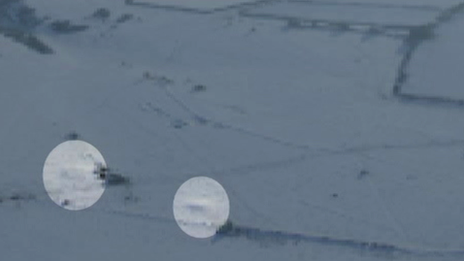Snow survey uncovers prehistoric sites in Wales
- Published

The Bronze Age burial site highlighted here at Beacon Down near Ogmore-by-Sea, in the Vale of Glamorgan, is regarded as an "exceptional discovery"
While snow has not been a welcome sight for all this winter, it has turned up some remarkable surprises for experts charting the history of Wales.
Bronze Age burial mounds have been found in the Vale of Glamorgan and a moated site at Llangorse lake, near Brecon, Powys.
The Royal Commission on the Ancient and Historical Monuments of Wales (RCAHMW) made about 40 discoveries in the snow.
It showed up monuments from the air that could not be seen at ground level.
Dr Toby Driver said this winter had offered "exceptional conditions".
The pair of prehistoric burial mounds discovered at Beacon Down, near Ogmore-by-Sea during the aerial reconnaissance date back 4,500 years, said Dr Driver, who is an aerial investigator with RCAHMW.
"The snow has been causing a lot of problems but from the air it's like a white blanket has been laid over the landscape," he told BBC Radio Wales.
"You can see every lump and bump that people have made from history into prehistory, and it's yielded some pretty impressive views from the air this winter."
Top of the list of those winter discoveries is the burial site near Ogmore, Dr Driver explained.
'Still untouched'
"Nobody knew about them until we discovered them under snow this year. The people are still inside them as far as we can be aware: the barrow mound, the earth mound is still intact.
"And the Vale of Glamorgan is very intensively cultivated. It has been since medieval times. Most of the prehistoric sites have been ploughed away and yet here we have these ancient sites still there, still untouched but completely unknown."
The discovery surveys done under the RCAHMW flying programme in extreme weather conditions - they carry out the work in the heat of summer too - mean "sometimes the story of Wales gets flipped on its head," said Dr Driver.

The survey also uncovers more urban views, such as this of Townhill in Swansea
Each year about 200 discoveries are made.
This winter the team were also able to photograph earth works which they already knew about, including the remains of a Norman castle at Painscastle near Builth Wells.
'Real time capsule'
The images which also include urban views of Swansea and Cardiff are then stored in the commission's database and can be used by communities researching local history projects, he said.
Sometimes projects are passed onto archaeological trusts and sometimes, as in the case of a Roman villa discovered near Aberystwyth, the commission chooses to carry out its own research.
"Excavation is a big job," said Dr Driver.
"Every now and then we do excavate some of the aerial discoveries we make: a site is just too important to leave it in the ground."
However, the barrows near Ogmore - which he described "a real time capsule of information" will be left.
"But we've visited them, we'll make a survey of them as well. Where we need to we can talk to the landowners. Those barrows are on Crown land so we don't need to [talk to the owners] there.
"But we get out to the more important sites to learn more about what we can see at ground level."
- Published11 March 2013